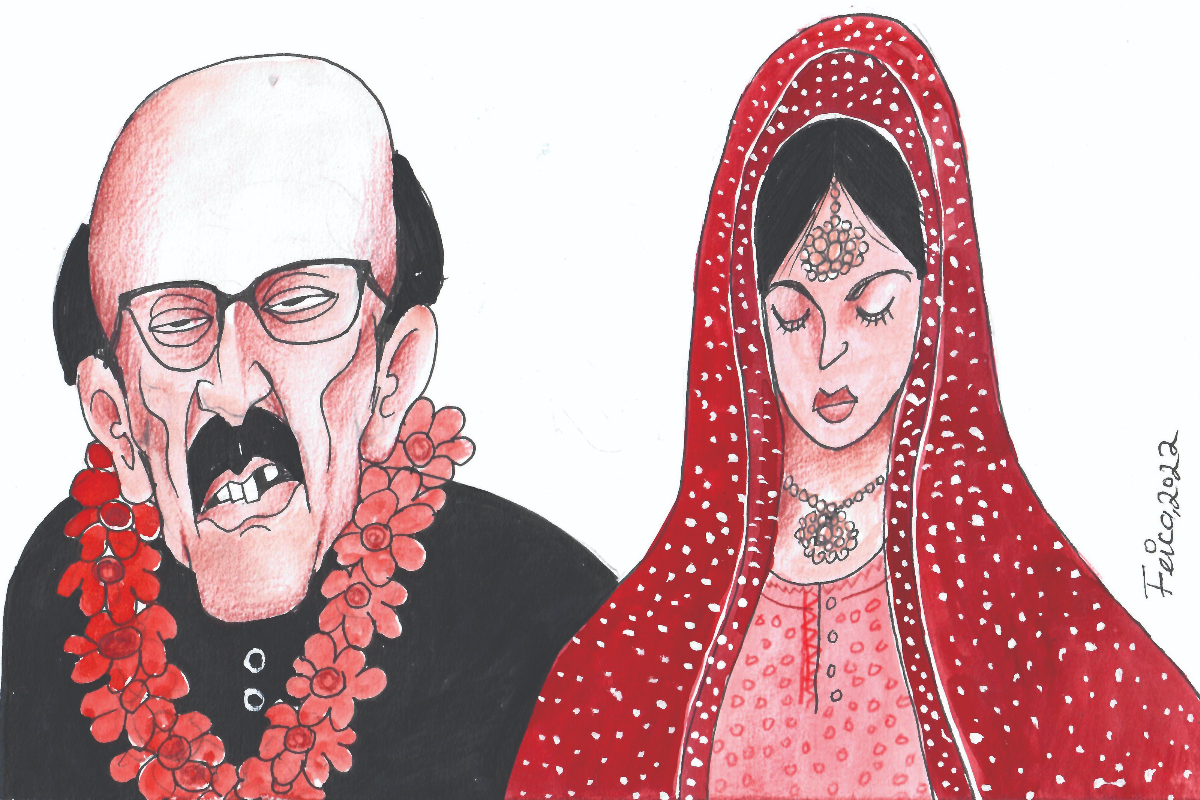
Despite many protests, the age old custom continues
Shahida was 14 when she got married to Adeel, her 24-year-old cousin. She was a student of class 8, at a school in Shahdara, Lahore. But she dropped out of school to move into her husband’s home.
Too young to face the challenges of married life, Shahida was often a victim of domestic violence. She also had a child while she was barely old enough to understand what motherhood actually was. During her pregnancy she neither received adequate diet, nor did she get good care from her in-laws. As she was not mature enough to take proper care of herself, her health deteriorated drastically.
Ultimately, her husband divorced her and took custody of their daughter, effectively breaking up their family. Now, Shahida herself lives with her parents in poor circumstances. She is not educated enough to get a good job and support herself financially.
The issue of child marriage has always plagued our society. It tends to occur among the country’s most marginalised and vulnerable communities. While both boys and girls are married off early in many parts of Pakistan, a greater number of girls become victims of this age-old custom. The practice largely stems from the prevalence of gender inequality in society and patriarchal cultural norms, and it is further perpetuated due to weak legislation.
In 2020, 119 cases of child marriages were reported in the country, of which 95 per cent were of girls and five per cent were of boys, according to a report by Islamabad-based Sahil, a non-governmental organisation working for child protection.
Child marriage is a grave threat to the lives and prospects of young girls. It denies them their childhood, jeopardises their health and limits opportunities for them. How can the state and society recognise this tradition as a crime and protect young girls from it?
According to the Pakistan Demographic and Health Survey (PDHS) 2017-2018, 3.6 per cent of girls under the age of 15 are married off while 18.3 per cent of girls married off are under 18. However, UNICEF reports 21 per cent of Pakistani girls are married by the age of 18, and three per cent before 15 years of age. Another report by the international agency claims that Pakistan has the sixth-highest number of child brides in the world.
At thirteen and a half, Shama eloped with her tutor Asif. After the disappearance of the class-nine student, her parents approached the police to register a case. They provided the court with all the necessary documents, including their teenage daughter’s birth certificate and school certificate, which proved Shama to be a child under the legally marriageable age.
But the police manipulated the case for Asif’s benefit when collecting evidence. Asif presented another birth certificate, which showed Shama to be 18 years old.Thesessions court decided the case in favour of Asif, he got out on bail and started living with his child bride.
An ineffective birth registration system contributes significantly to the incidence of child marriages. Registration of births, especially of girls, is never given a priority. This creates room for manipulation of a girl’s age at the time of marriage. In fighting Shama’s case, her parents suffered at the hands of a fragile justice system, poor implementation of the law, and the collusion of corrupt police officials as well as an inefficient birth registration system.
In Pakistan, there are various other causes of child marriages, the most prevalent being weak legislation and lack of political will to ensure implementation of existing laws. There is a lack of awareness among the public about the damaging effects of child marriages, especially within tribal and feudal societal structures, extreme poverty and illiteracy.
Child marriage is a form of sexual abuse in which the child is subjected to assault and deprived of their childhood. It affects the psychological well-being and intellectual, personal and social growth of the child. Girls who marry are more likely to drop out of school than other girls. If we look at our Gender Parity Index across Pakistan, only 87 per cent girls are enrolled in primary school for every 100 boys (this number falls to as low as 56 per cent for the erstwhile FATA region).
The earlier girls are married, the more children they tend to bear, which contributes to overpopulation. Child brides face greater pregnancy-related health risks and their babies are more likely to have health problems. The high rates of maternal and infant mortality in Pakistan are closely linked to early marriage. Younger girls are more likely to face domestic violence than women who marry later. Additionally, child marriage leads to poverty when it limits the earning ability for girls because of dropping out of schools in many cases.
Consent is the basic principle for marriage, in which both persons should independently be able to accept or refuse according to their own free will.
Consent is the basic principle for marriage, in which both persons should independently be able to accept, or refuse, according to their own free will. Does a child’s consent constitute informed consent? Is a child intellectually mature enough to make a wise decision and be able to take care of themselves, let alone a family?
Marriage is a lifetime contract, and a child who does not even understand what a contract is, cannot be expected to choose her life partner. When a child is not allowed to hold a Computerised National Identity Card (CNIC), cannot get her driving license, cannot vote, cannot sign any other contract, how can she sign a contract of marriage?
Currently, the federal law is based around an act passed in 1929, where the age limit for marriage was 14 years and above. It was increased to 16 years by the Muslim Family Laws Ordinance, 1961. The current law sets the legal marriage age at 16 for girls and 18 for boys, setting different and thereby discriminatory marriageable ages for girls and boys.
After 2010, the prevention of child marriages became a provincial subject. Sindh is the only province so far, to have passed a law barring marriage under the age of 18. In Sindh, the Child Marriages Restraint Act, 2013, makes underage marriage a cognizable and non-compoundable offence. This means that the police can take action on their own, to arrest offenders upon any information, and no private conciliatory deals can be made between families, communities or jirgas to bypass the law.
The Punjab Marriage Restraint (Amendment) Act, 2015, still permits girls to be married at 16. Khyber Pakhtunkhwa and Balochistan continue to be governed by the 1929 act, like the federal law. However, in a landmark judgment by the Islamabad High Court, anyone married below the age of 18, their marriage would be deemed void.
Pakistan ratified the Convention on the Rights of the Child in 1990; it defines a child as “every human being below the age of 18 years unless, under the law applicable, majority is attained earlier.”
The UN Committee on the Rights of the Child, in its concluding observations and recommendations about Pakistan’s Fifth Periodic Report in 2016, notes that there is a difference between the minimum legal age for the marriage of boys (18years) and that of girls (16 years). Therefore, the committee recommended Pakistan for the “full harmonisation of its legislation as regards the definition of a child so as to define a child as every human being below the age of 18 years.”
The Pakistani government has a number of key rights’ challenges, and the rights of girls must be prioritized, too. Under the UN Sustainable Development Goals (SDGs), countries around the world, including Pakistan, have pledged to end marriages before age 18 by the year 2030. To save children from early marriage legislation in the entire country must enforce restraint, be it federal or provincial territories. For stronger implementation, the provision of CNIC should be made mandatory for registration of marriages.
A nationwide campaign can also help raise awareness on the damaging effects of child marriage. National Human rights institutions, such as the National Commission on the Rights of Child, must take notice of the problem and offer suitable policy recommendations. To combat child marriages, education for every child is a must. Implementation of support programmes can help empower girls at risk. Girls’ access to supported education choices should be improved and they should be sent to school instead of being bound in marriage. This will help enable our younger generations to live healthier, freer lives in a more prosperous country.
Catch all the Breaking News Event and Latest News Updates on The BOL News
Download The BOL News App to get the Daily News Update & Live News.












 Read the complete story text.
Read the complete story text. Listen to audio of the story.
Listen to audio of the story.